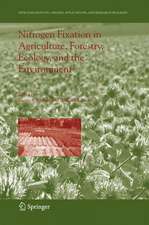Modern Potting Composts: A Manual on the Preparation and Use of Growing Media for Pot Plants
Autor A. C. Bunten Limba Engleză Paperback – 14 apr 2012
Preț: 387.20 lei
Nou
Puncte Express: 581
Preț estimativ în valută:
74.09€ • 77.36$ • 61.32£
74.09€ • 77.36$ • 61.32£
Carte tipărită la comandă
Livrare economică 04-18 aprilie
Preluare comenzi: 021 569.72.76
Specificații
ISBN-13: 9789401179386
ISBN-10: 9401179387
Pagini: 280
Ilustrații: 278 p.
Dimensiuni: 155 x 235 x 15 mm
Greutate: 0.4 kg
Ediția:1976
Editura: SPRINGER NETHERLANDS
Colecția Springer
Locul publicării:Dordrecht, Netherlands
ISBN-10: 9401179387
Pagini: 280
Ilustrații: 278 p.
Dimensiuni: 155 x 235 x 15 mm
Greutate: 0.4 kg
Ediția:1976
Editura: SPRINGER NETHERLANDS
Colecția Springer
Locul publicării:Dordrecht, Netherlands
Public țintă
ResearchCuprins
1 Why Change?.- 1.1 Loam composts.- 1.2 Loamless composts.- 2 Alternative Materials.- 2.1 Peat.- 2.2 Other organic materials.- 2.3 Mineral materials.- 2.4 Plastics.- 3 Physical Aspects.- 3.1 Physical terminology.- 3.2 Physical requirements of composts.- 3.3 Energy concept of water in composts.- 3.4 Water absorption and release by composts.- 3.5 Formulation of composts: physical principles.- 4 Principles of Nutrition.- 4.1 Cation exchange capacity.- 4.2 Anion exchange capacity.- 4.3 Availability of nutrients: loam v. loamless composts.- 4.4 Nutrient uptake by the plant.- 4.5 Acidity (pH).- 4.6 Lime requirement.- 4.7 Soluble salts.- 5 Nitrogen.- 5.1 Nitrogen and pot plants.- 5.2 Forms of mineral nitrogen.- 5.3 Slow release fertilisers.- 5.4 Choice of fertiliser type.- 5.5 Nitrogen and peat.- 6 Other Macro-Elements.- 6.1 Phosphorus.- 6.2 Potassium.- 6.3 Calcium.- 6.4 Magnesium.- 6.5 Sulphur.- 6.6 Mineral soil and peat comparison.- 6.7 Nutrient and environment interactions.- 6.8 Fertiliser analysis and salt index.- 6.9 Plant mineral levels.- 7 Micro-Elements.- 7.1 Boron.- 7.2 Copper.- 7.3 Manganese.- 7.4 Molybdenum.- 7.5 Iron.- 7.6 Zinc.- 7.7 Chloride.- 7.8 Aluminium.- 7.9 Fritted micro-elements.- 7.10 Chelated micro-elements.- 7.11 Other sources.- 7.12 Micro-element availability.- 8 Compost Formulation and Preparation.- 8.1 Historical.- 8.2 Denmark.- 8.3 Finland.- 8.4 Germany.- 8.5 Ireland.- 8.6 Netherlands.- 8.7 United Kingdom.- 8.8 United States of America.- 8.9 Sawdust and bark composts.- 8.10 Azalea composts.- 8.11 Proprietary formulations.- 8.12 Compost preparation.- 9 Liquid Feeding.- 9.1 Importance of liquid feeding.- 9.2 Formulating liquid feeds.- 9.3 Practical aspects of feeding.- 9.4 Diluting equipment.- 9.5 Quality of irrigation water.- 10 Irrigation Systems.- 10.1 Drip systems.- 10.2 Capillary watering.- 10.3 Flooded benches.- 11 John Innes Composts.- 11.1 Formulation.- 11.2 Compost ingredients: loam.- 11.3 Peat.- 11.4 Sand.- 11.5 Sterilisation.- 11.6 Characteristics and use.- 11.7 Composts for calcifuge plants (JIS ( A )).- 12 Heat Sterilisation.- 12.1 Thermal deathpoints.- 12.2 Methods of heat sterilisation.- 12.3 Steam.- 12.4 Steam—air mixtures.- 12.5 Flame pasteuriser.- 12.6 Electrical sterilisers.- 12.7 Other methods.- 12.8 Chemistry of heat sterilisation.- 12.9 Rules for heat sterilisation.- 13 Chemical Sterilisation.- 13.1 Soil fumigants.- 13.2 Fungicides.- 13.3 Insecticides.- 14 Plant Containers.- 14.1 Clay v. plastic pots.- 14.2 Paper and peat pots.- Appendices.- 1 Metric conversions.- 2 Imperial and us capacity measures.- 3 Illumination and radiation units.- 4 Atomic weights.- 5 Formulae and molecular weights of some commonly used chemicals.- 6 Chemical gravimetric conversions.- 7 Temperature conversions.
















